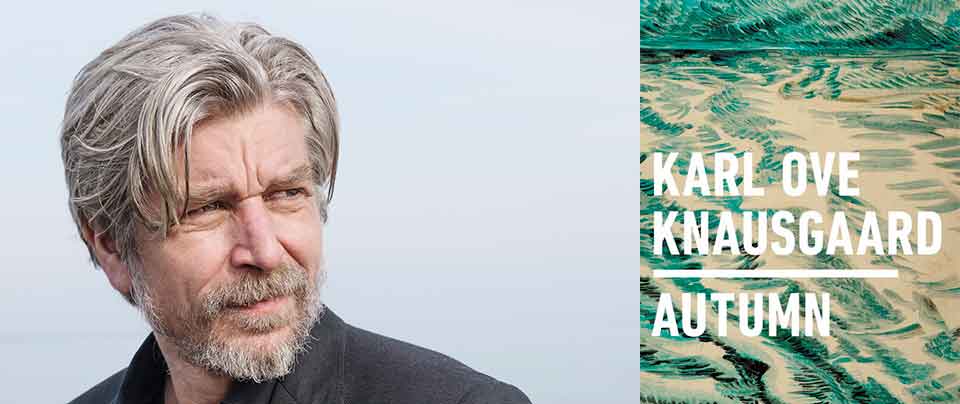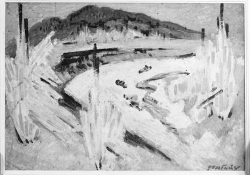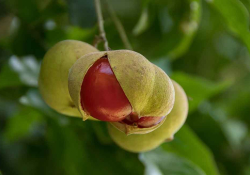Postmodern Idylls Framed for Family: Reading Karl Ove Knausgård’s Autumn

What are the advantages and pitfalls of the short-short nonfiction essay? And what are the advantages and pitfalls of framing creative nonfiction (CNF) work about one’s own family?
Possible answers to these craft questions can found in Autumn (Penguin, 2017), celebrated Norwegian writer Karl Ove Knausgård’s first book-length work in English since his name-making six-volume My Struggle autofiction saga. Published in the US and UK this past fall, the book is essentially a collection of mini-essays framed for an unborn daughter; it’s also the first in a cycle of four volumes, Årstid encyklopedien (Seasonal Encyclopedia), published in the original Norwegian in 2015 and 2016.
The book’s presentation and conceptual conceit requires further explication: a short letter addressing the author’s unborn fourth child precedes each of Autumn’s three month-sections (“September,” “October,” and “November”), with each month-section containing exactly twenty lyrically ruminative vignettes (sixty in total), none running longer than three pages in length. The book also includes pastoral illustrations by Norwegian artist Vanessa Baird that appear at the beginning of every month-section. Another two rather nightmarish oil paintings by Baird appear seemingly randomly in the middle of the first and third sections but are not of any obvious import to the book’s overall conceit and arguably could have been excised.[i]
Autumn’s sixty mini-essays span an encyclopedic range of topics: from everyday objects and animals (e.g., “Apples,” “Frogs,” “Cars”), parts of the human body and its fluids (e.g., “Mouth,” “Labia,” “Vomit”), human sensations and intangible concepts (e.g., “Loneliness,” “Pain,” “Silence”), adult concerns (e.g., “Petrol,” “War,” “Oil Tankers”), and famed artists (e.g., “Van Gogh,” “Flaubert,” and early twentieth-century German photographer August Sander) to natural phenomenon and unlikely objects of inquiry (e.g., “Lightning,” “The Migration of Birds,” “Toilet Bowls”), among others. The project, at first glance, may seem to be one of randomness, an attempt to reconcile observations of the natural world with the contemporary condition of a hyperfragmented attention span.
We know the Seasonal Encyclopedia is the result of two projects coming together, beginning with letters Knausgård started writing for an unborn third daughter: “I wanted to write something for her, a diary or letter, for her to read when she was older—about how things looked like around our home before she was born, what her family was like, our thoughts and habits” (Paris Review interview). Around the same time, Knausgård was commissioned by an editor at an American magazine to write a series of mini-essays to be published in every issue for a year; and though the editor left the magazine and the pieces he wrote never ran, “in that brief form I’d found something that appealed to me” (Paris Review).
The book appears to borrow genre conventions from educational texts written for young children. By framing every month-section with a letter to his unborn daughter, the sixty short texts take on the form of a time capsule or a lexicon of various tangible and intangible things and concepts Knausgård’s daughter might one day want to understand. “These . . . books aren’t about psychological states,” Knausgård said of the aesthetic he cultivated for the Seasonal Encyclopedia. “They’re about things, material realities. Of course, when the birth of a child takes center stage, it automatically lends the whole project a tinge of optimism” (Paris Review). Remove the family frame, then, and all we’re left with are “things.”
Throughout Autumn, Knausgård’s register of language remains semidetached and unemotive. I cannot speak to Knausgård’s prose in the original Norwegian, but here the prose mainly consists of unadorned declarative sentences of a somewhat academic flavor thrumming steadily and inquisitively along. The three letters he writes to his unborn daughter are written in a plainly pensive fashion: “Three siblings, a mother and a father, that’s us”; “. . . all the while you are growing silently in the darkness”; “Everything that happened before you were born will maybe come to seem almost mythical to you.” The apparently random topics Knausgård writes about reflect an attempt at re-achieving a sense of childlike wonder about the world. Simple descriptions of what a thing is or how it works for the benefit of a child become a springboard for free association into memory and worldly (if not fatherly) insight: “I just write about the things I see in front of me. The more personal aspects, how and what I think, come through in descriptions. . . . I’m interested in the idea of looking at things without hierarchy, in the world as it is before we start categorizing it” (Paris Review). The book, in this sense, is a worthy CNF study of defamiliarization.
Each mini-essay may purport to limn or define the entire working essence of a thing, but the scope of each vignette is limited to just one man’s worldview and understanding.
Every one of these sixty mini-essay aims to make something magical or wondrous of the otherwise quotidian. Many are directly inspired by the rural part of Sweden’s southernmost province where Knausgård was then living (e.g., “Beekeeping,” “Stubble Fields,” “Chimneys”), which harkens back to the roots of the mini-essay form—the poetry written about Greek pastoral life in the third century BC by Theocritus, to whom the “idyll” form is commonly attributed: “A short poem describing an incident of country life in terms of idealized innocence and contentment; or any such episode in a poem or prose work” (Oxford Dictionary of Literary Terms). Every mini-essay in Autumn is structured like a prose-poem idyll and occasionally takes on the qualities of a diary, documenting the author’s everyday household chores like picking up his three kids from school and making meals. Each may purport to limn or define the entire working essence of a thing, but the scope of each vignette is limited to just one man’s worldview and understanding. This is, in the end, a project dedicated to an individual written by another individual.
A close, sequential reading of “Badgers” reveals a narrative method common to nearly every mini-essay found in Autumn:
- The topic arrives unexpectedly, having been preceded by (in the order of appearance): “Fingers,” “Autumn Leaves,” “Stubble Fields,” and “Bottles.”
- The mini-essay begins informationally, in the style of an encyclopedia for children: “One would think that the badger, with its characteristic snout, which is white and black and resembles nothing else in the fauna of the Nordic countries, and its broad, somehow flat body would be remarkable enough that stories would be told about it.”
- The author then delves into interesting, though unsourced, factlike claims: “[The badger] lives in clans of ten to fifteen members, typically in dense forest, often in the vicinity of open fields, where it gets its food at night. The badger is closely associated with the earth; it digs networks of burrows underground, which sometimes remain in use for several hundred years.”
- A rhetorical question opens a line of inquiry: “What is the badger really like?”
- Which then leads into a digression concerning larger cultural concerns: “That the badger has not been subsumed into culture enables us to see what culture does to the other animals which we have some kind of hold over, which we are familiar with and use to populate the stories we tell our children.”
- Which suddenly transitions toward distant-past memoir: “I myself have only seen a badger a handful of times, always in the same place, outside the house where I lived as a teenager.”
- Which is followed by a subsequent return to the present with flashes of insight via defamiliarization: “Now when I drive along the motorway to Malmö and see one of the beautiful, black-and-white-snouted badgers lying bloodied and motionless on the roadway, I am filled with a dull, hopeless rage, for the thing that killed it is a structure I help to maintain and which works so well for me that I am unwilling to renounce it.”
- The mini-essay ends on an Aesop’s fable–like moral—presumably a takeaway for the author’s unborn daughter: “[Driving a car] is an original sin, it belongs to everyone and can only be undone by all of us together.” (119–21)[ii]
Involving one’s own family in creative nonfiction is always something of a dicey business.
Nowhere in the text of Autumn does Knausgård directly comment on the purpose of his Seasonal Encyclopedia project. The conceptual grouping of the mini-essays into the four seasons and then into separate months, along with the letters to his unborn third daughter preceding every month-section, imbues the larger project with larger existential significance. It also leads us to assume that every mini-essay is dedicated to a to-be-born daughter, even when the subject is trivial or profane (e.g., “Chewing Gum” or “Labia”). There is something very reality-television-like about Knausgård’s project: in every letter to his unborn daughter we are made privy to a detailed and intimate portrait of his family—albeit the personal information we’re given in Autumn is hardly salacious.[iii] Involving one’s own family in CNF is always something of a dicey business. It won’t be long until we can directly ask Knausgård’s then-unborn daughter what she makes of a project she had no say in.
Postmodern parenting questions aside, the composition of Autumn smacks of a highly regimented writerly discipline. Every letter to Knausgård’s unborn daughter is dated, which presumably means the twenty mini-essays contained in every month-section were written in a month’s time. In theory, the micromodular essay form should allow for a more prolific output, though we don’t know how many mini-essays Knausgård wrote and then didn’t include, or how many he began to write and then abandoned. The flash or short-short form (typically defined as a thousand words or less) inherently demands incisive brevity. The form forces the writer to articulate only a few details that still tell or suggest a larger story. In Autumn, Knausgård doesn’t use every mini-essay to build on a larger story-driven narrative, but the form, I believe, should be employed for narrative storytelling, especially for stories that have no definite beginnings or endings.
Autumn perhaps works best as a study of disciplined writerly habits.
But which stories are more suited for the short-short form? And which stories are more suited for a more in-depth and lengthy study? Given the ultimately granular breadth of Autumn, I’m not sure Knausgård has an answer for us. As to what Autumn can teach us about the short-short nonfiction essay and the trappings of writing one’s own family into CNF work, I will have to reserve judgment until I’m able to read the rest of the Seasonal Encyclopedia, but for now: Autumn perhaps works best as a study of disciplined writerly habits. The book does not work as a book of revelations concerning the father–unborn daughter bond or as a working compendium of all things human. If the project weren’t framed for family, or if this were the work of a less famed author, it’s conceivable few would’ve taken note of its publication.
Autumn does, however, give us license to write daily without exceptions, for at least a full season, with an exacting eye on completing a full single short-form work every day. To then reframe what results as a whole for one’s own family virtually assures that every small piece will then be infused with new and unexpected meanings.
Washington, DC
Editorial note: For more on flash nonfiction, check out the special section in the January 2015 issue of WLT.
[i] The first is a supine, blood-red-skinned, peacefully sleeping kobold of some kind; the second is a badger pointing its nose at the exposed white undergarment of a supine young girl in a blue frilly summer dress.
[ii] The following mini-essays proceed according to the same structure (in the order they appear): “Infants,” “Cars,” “Loneliness,” and “Experience,” with none making any explicit reference to the other.
[iii] Worth noting: wholly absent from Autumn is the fact that Knausgård and his wife (also a writer) divorced following the birth of the child the letters are addressed to (Newsweek).










